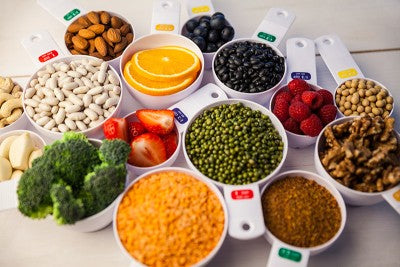
If you’ve ever downed an entire pint of ice cream in one sitting or made an extra trip (or two) at an all-you-can eat buffet, chances are you probably noticed a jump when you got on the scale at the end of the week.
As we get older, most of us come to the realization that we can no longer eat as much as we want without gaining weight. More often than not, keeping your weight in check requires discipline and effort—especially when it comes to portion sizes.
What Is A Portion, and Why Does It Matter?
Simply put, a portion refers to the amount of a particular food that you consume in one sitting. Contrary to popular belief, this isn’t the same as a serving size. A serving size, like the ones printed on food labels at the grocery store or the nutritional guidelines set forth by the FDA, is a recommended amount of a specific food. For example, a serving size of your favorite potato salad may be half a cup, but the amount you scoop onto your plate (which may be more or less than ½ cup) is the portion.
Dietary guidelines are developed by the US government and include recommendations for healthy, balanced eating. Over the years, these guidelines have evolved and are no longer based on a specific number of servings needed per day. Instead, they emphasize the overall choices needed for a healthy diet; for example, focusing on choosing a variety of nutrient dense foods while limiting calories from added sugars and saturated fats.
That doesn’t mean you have to ignore serving sizes. Becoming familiar with them and making it a habit to check the number of servings you eat will help you control your portions and the overall calories you eat.
Portion Control and Your Weight
Controlling your portions keeps your weight in check for a few reasons. In addition to eating fewer calories, eating smaller portions may condition your body to feel full with smaller amounts of food, so you can still cut back and feel satisfied. This decreased amount of food can help you lose weight.
Controlling your portions will also help you avoid overeating and the uncomfortably full “food coma” that often results.
With that in mind, becoming more aware of serving sizes, as well as your own portions, is the first step to controlling your weight.
Portion Distortion
This isn’t always easy, thanks in part to portion sizes that have gotten substantially larger over time. (Think Big Gulps at gas stations and the option to “super size” fast food orders.) In fact, portion sizes 20 years ago were significantly smaller than they are today. 20 years ago, the average cheeseburger had 333 calories; today, that number has increased to 590.
It’s no secret that expanding portion sizes and an increase in obesity go hand in hand. Consuming bigger portions means consuming more calories, which results in weight gain if left unchecked. The massive portion sizes found in today’s food add an extra 50 to 150 calories every year, which adds up to a 10-pound weight gain over the course of a year.
One of the problems of portion distortion, aside from the excess weight, is that is distorts our thinking. Research has shown that the more food a person is served, the greater amount they will eat. Think of the portion you received the last time you went to a restaurant. Restaurant portions, on average, are two to three times the recommended healthy amount by the U.S. Dietary Guidelines. The same goes for packaged foods. A large bag of chips is usually between 8-10 servings, but most people don’t measure servings out.
Tips For Controlling Portions
Learning to control your portion sizes isn’t difficult, but it does take some practice. A few ways you can learn to control your portions include:
Use visual cues.
An easy way to gauge serving sizes is to compare it to your own hand. (Check out this handy chart for reference.) For example, a 3-ounce serving of meat is about the size of the palm, 8 ounces of milk or juice is the size of a fist, and a half cup of rice or oats is a handful.
Measure your food.
For a few weeks, use measuring cups and spoons to measure serving sizes of the foods you eat. This will help you compare your typical portion to a serving size. It won’t take long before you can accurately measure servings of your favorite foods without measuring them.
Get to know recommended amounts.
Read the serving sizes on nutrition labels and compare them to MyPlate.gov’s recommended serving sizes. For example, a half-pound burger from a restaurant is more than the recommended 5 ounces of meat a day, and a standard bakery bagel is 6 ounces, which also exceeds the recommended 5 ounces of grains.
The exception to this is fruits and vegetables. Rather than limiting portions, aim to get plenty of fruits and vegetables of different varieties.
Portion your snack foods.
If you have a tendency to eat snack foods straight from the bag, consider measuring out serving sizes in portion control containers or sandwich bags. That way, you can grab a snack without having to worry about overeating. You can also buy pre-measured or 100-calorie snacks.
Use a smaller plate.
Another easy and effective way to control your portions is to use smaller plates when eating at home. Your plate will look full, so you won’t feel deprived, but you’ll end up eating less.
Practice mindful eating.
Eating mindfully will also help you control your portion size. The concept of mindful eating helps you become more aware of what you eat and how much. Some studies have also shown that mindful eating can assist with weight loss, partly because it results in eating less.
Don’t clean your plate.
Just because it’s on your plate doesn’t mean you have to eat it. Stop when you’re full. At a restaurant, ask the server to box up half of your meal and take it home to eat later.
If you want to control your weight, controlling your portions is a great way to start. Being aware of your portions can help you make healthier food choices while keeping extra pounds at bay.
Written By: Jill Overmyer
Fact-Checked and Edited By: Scarlett Full, in-house Registered Dietitian
